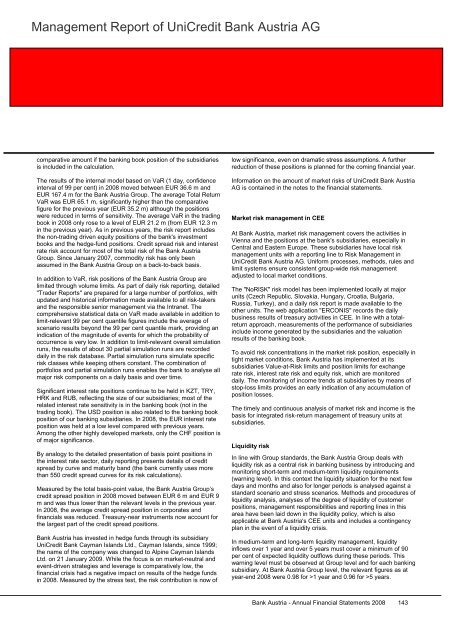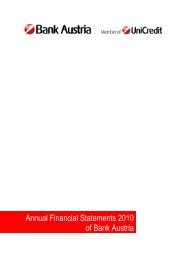Annual Financial Statements 2008 of Bank Austria
Annual Financial Statements 2008 of Bank Austria
Annual Financial Statements 2008 of Bank Austria
You also want an ePaper? Increase the reach of your titles
YUMPU automatically turns print PDFs into web optimized ePapers that Google loves.
Management Report <strong>of</strong> UniCredit <strong>Bank</strong> <strong>Austria</strong> AG<br />
comparative amount if the banking book position <strong>of</strong> the subsidiaries<br />
is included in the calculation.<br />
The results <strong>of</strong> the internal model based on VaR (1 day, confidence<br />
interval <strong>of</strong> 99 per cent) in <strong>2008</strong> moved between EUR 36.6 m and<br />
EUR 167.4 m for the <strong>Bank</strong> <strong>Austria</strong> Group. The average Total Return<br />
VaR was EUR 65.1 m, significantly higher than the comparative<br />
figure for the previous year (EUR 35.2 m) although the positions<br />
were reduced in terms <strong>of</strong> sensitivity. The average VaR in the trading<br />
book in <strong>2008</strong> only rose to a level <strong>of</strong> EUR 21.2 m (from EUR 12.3 m<br />
in the previous year). As in previous years, the risk report includes<br />
the non-trading driven equity positions <strong>of</strong> the bank's investment<br />
books and the hedge-fund positions. Credit spread risk and interest<br />
rate risk account for most <strong>of</strong> the total risk <strong>of</strong> the <strong>Bank</strong> <strong>Austria</strong><br />
Group. Since January 2007, commodity risk has only been<br />
assumed in the <strong>Bank</strong> <strong>Austria</strong> Group on a back-to-back basis.<br />
In addition to VaR, risk positions <strong>of</strong> the <strong>Bank</strong> <strong>Austria</strong> Group are<br />
limited through volume limits. As part <strong>of</strong> daily risk reporting, detailed<br />
"Trader Reports" are prepared for a large number <strong>of</strong> portfolios, with<br />
updated and historical information made available to all risk-takers<br />
and the responsible senior management via the Intranet. The<br />
comprehensive statistical data on VaR made available in addition to<br />
limit-relevant 99 per cent quantile figures include the average <strong>of</strong><br />
scenario results beyond the 99 per cent quantile mark, providing an<br />
indication <strong>of</strong> the magnitude <strong>of</strong> events for which the probability <strong>of</strong><br />
occurrence is very low. In addition to limit-relevant overall simulation<br />
runs, the results <strong>of</strong> about 30 partial simulation runs are recorded<br />
daily in the risk database. Partial simulation runs simulate specific<br />
risk classes while keeping others constant. The combination <strong>of</strong><br />
portfolios and partial simulation runs enables the bank to analyse all<br />
major risk components on a daily basis and over time.<br />
Significant interest rate positions continue to be held in KZT, TRY,<br />
HRK and RUB, reflecting the size <strong>of</strong> our subsidiaries; most <strong>of</strong> the<br />
related interest rate sensitivity is in the banking book (not in the<br />
trading book). The USD position is also related to the banking book<br />
position <strong>of</strong> our banking subsidiaries. In <strong>2008</strong>, the EUR interest rate<br />
position was held at a low level compared with previous years.<br />
Among the other highly developed markets, only the CHF position is<br />
<strong>of</strong> major significance.<br />
By analogy to the detailed presentation <strong>of</strong> basis point positions in<br />
the interest rate sector, daily reporting presents details <strong>of</strong> credit<br />
spread by curve and maturity band (the bank currently uses more<br />
than 550 credit spread curves for its risk calculations).<br />
Measured by the total basis-point value, the <strong>Bank</strong> <strong>Austria</strong> Group’s<br />
credit spread position in <strong>2008</strong> moved between EUR 6 m and EUR 9<br />
m and was thus lower than the relevant levels in the previous year.<br />
In <strong>2008</strong>, the average credit spread position in corporates and<br />
financials was reduced. Treasury-near instruments now account for<br />
the largest part <strong>of</strong> the credit spread positions.<br />
<strong>Bank</strong> <strong>Austria</strong> has invested in hedge funds through its subsidiary<br />
UniCredit <strong>Bank</strong> Cayman Islands Ltd., Cayman Islands, since 1999;<br />
the name <strong>of</strong> the company was changed to Alpine Cayman Islands<br />
Ltd. on 21 January 2009. While the focus is on market-neutral and<br />
event-driven strategies and leverage is comparatively low, the<br />
financial crisis had a negative impact on results <strong>of</strong> the hedge funds<br />
in <strong>2008</strong>. Measured by the stress test, the risk contribution is now <strong>of</strong><br />
low significance, even on dramatic stress assumptions. A further<br />
reduction <strong>of</strong> these positions is planned for the coming financial year.<br />
Information on the amount <strong>of</strong> market risks <strong>of</strong> UniCredit <strong>Bank</strong> <strong>Austria</strong><br />
AG is contained in the notes to the financial statements.<br />
Market risk management in CEE<br />
At <strong>Bank</strong> <strong>Austria</strong>, market risk management covers the activities in<br />
Vienna and the positions at the bank's subsidiaries, especially in<br />
Central and Eastern Europe. These subsidiaries have local risk<br />
management units with a reporting line to Risk Management in<br />
UniCredit <strong>Bank</strong> <strong>Austria</strong> AG. Uniform processes, methods, rules and<br />
limit systems ensure consistent group-wide risk management<br />
adjusted to local market conditions.<br />
The "NoRISK" risk model has been implemented locally at major<br />
units (Czech Republic, Slovakia, Hungary, Croatia, Bulgaria,<br />
Russia, Turkey), and a daily risk report is made available to the<br />
other units. The web application "ERCONIS" records the daily<br />
business results <strong>of</strong> treasury activities in CEE. In line with a totalreturn<br />
approach, measurements <strong>of</strong> the performance <strong>of</strong> subsidiaries<br />
include income generated by the subsidiaries and the valuation<br />
results <strong>of</strong> the banking book.<br />
To avoid risk concentrations in the market risk position, especially in<br />
tight market conditions, <strong>Bank</strong> <strong>Austria</strong> has implemented at its<br />
subsidiaries Value-at-Risk limits and position limits for exchange<br />
rate risk, interest rate risk and equity risk, which are monitored<br />
daily. The monitoring <strong>of</strong> income trends at subsidiaries by means <strong>of</strong><br />
stop-loss limits provides an early indication <strong>of</strong> any accumulation <strong>of</strong><br />
position losses.<br />
The timely and continuous analysis <strong>of</strong> market risk and income is the<br />
basis for integrated risk-return management <strong>of</strong> treasury units at<br />
subsidiaries.<br />
Liquidity risk<br />
In line with Group standards, the <strong>Bank</strong> <strong>Austria</strong> Group deals with<br />
liquidity risk as a central risk in banking business by introducing and<br />
monitoring short-term and medium-term liquidity requirements<br />
(warning level). In this context the liquidity situation for the next few<br />
days and months and also for longer periods is analysed against a<br />
standard scenario and stress scenarios. Methods and procedures <strong>of</strong><br />
liquidity analysis, analyses <strong>of</strong> the degree <strong>of</strong> liquidity <strong>of</strong> customer<br />
positions, management responsibilities and reporting lines in this<br />
area have been laid down in the liquidity policy, which is also<br />
applicable at <strong>Bank</strong> <strong>Austria</strong>'s CEE units and includes a contingency<br />
plan in the event <strong>of</strong> a liquidity crisis.<br />
In medium-term and long-term liquidity management, liquidity<br />
inflows over 1 year and over 5 years must cover a minimum <strong>of</strong> 90<br />
per cent <strong>of</strong> expected liquidity outflows during these periods. This<br />
warning level must be observed at Group level and for each banking<br />
subsidiary. At <strong>Bank</strong> <strong>Austria</strong> Group level, the relevant figures as at<br />
year-end <strong>2008</strong> were 0.98 for >1 year and 0.96 for >5 years.<br />
<strong>Bank</strong> <strong>Austria</strong> - <strong>Annual</strong> <strong>Financial</strong> <strong>Statements</strong> <strong>2008</strong> 143
















